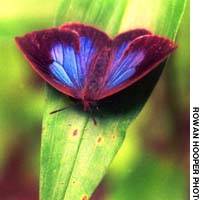* Japanese name: Murasaki shijimi
* Scientific name: Narathura japonica
* Description: If you catch sight of a butterfly flitting through the trees, it is likely to be an oakblue. The oakblue is a small (14-22 mm long) butterfly. Its black-bordered wings have beautiful, iridescent blue patches. It flies in quick, short bursts, during which the blue color on its wings can be clearly seen. The pretty spotted underside of the wings is visible when the oakblue perches with its wings folded up, but it often perches with its wings open, in sunlight, to warm itself. The caterpillars of this species (and of all the butterflies in the family Lycaenidae) are flattened and woodlouse-shape in appearance.
* Where to find them: In hilly parts of Honshu from Kanto westward, in evergreen broadleafed forests, from June to October. Oakblue caterpillars hatch from eggs two to four times a year. Adult butterflies that emerge from their pupal stage late in the year will hibernate over the winter.
* Food: Flowers, flower buds and the young leaves of flowers in evergreen (and sometimes deciduous) forests.
* Special features: The caterpillars of most species of butterfly have good reason to fear ants, because ants will eat them. But oakblue caterpillars form a remarkable relationship with ants and are often surrounded by them, without being harmed. On the abdomen of these caterpillars is a gland called Newcomer's organ, which secretes a honeylike fluid rich in sugars and amino acids. Ants are very fond of this secretion and queue up to feed on it. The cuticle (skin) of the caterpillar is thicker than usual, to protect against accidental ant nibbles. The relationship doesn't only benefit the ants -- the caterpillars get personal bodyguard protection. Every morning, the caterpillars are guided to their favorite plants by the ants, and each evening, they are guided back and into the safety of the ants' nest. In this way, the relationship between ants and caterpillars is much like that between a farmer and his cows. The caterpillars of several other species of butterfly in the family Lycaenidae also form relationships with ants, and in some species even the adult lives underground in the ants' nest.
9 mins ago

















With your current subscription plan you can comment on stories. However, before writing your first comment, please create a display name in the Profile section of your subscriber account page.